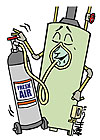
How much combustion air is enough? That is a question many of you ask. The reason for the increase of this question is that it seems, in many parts of the country, inspectors are asking for more and more combustion air.
So, how much is really needed?
Anytime there is a fuel-fired appliance, combustion air is needed. That, of course, makes sense. Plus, all of you remember basic chemistry - fuel plus air, plus ignition, results in flame and products of combustion. The air is needed for the flame.
Combustion air, for many years, often was ignored for smaller appliances. “Small” meaning residential water heaters and residential boilers - anything less than 80,000 Btu/hr.
The reason the combustion air was not rigidly enforced was because homes and commercial buildings were loosely constructed. There was enough air leakage to provide adequate combustion air.
As buildings got tighter, inspectors became more adamant about combustion air. Now, for a replaced water heater, you may be asked to add combustion air openings. But you replaced water heater for water heater, same Btu/hr. rating. Shouldn’t the new one work? The answer is, of course, assuming the old one worked.
To make matters worse, the inspectors are asking for huge openings, not one, but two. The minimum size they require is often 100 square inches.
You look at the size of these openings, then ask yourself, “How can a sealed combustion unit get away with a 2-inch-diameter PVC pipe when a little water heater needs two 100-square-inch openings?”
Don’t blame the inspector; blame the people who wrote the code requirements. The mechanical codes and fuel gas codes spell out the minimum amount of combustion air required for any fuel-burning appliance. When you take combustion air from inside the building, there is a statement in the code that specifies a minimum size opening of 100 square inches.
Take A Guess
In the code business, we call the minimum size of 100 square inches a SWAG number (SWAG meaning “scientific wild ass guess”). Basically, there is no rhyme or reason for the number. It sounds good, so let’s drop it in the code.That 2-inch-diameter PVC for the sealed combustion unit has only a little more than 3 square inches of opening for the combustion air. How can a unit get away with 97 percent less air?
The bottom line is that the codes go completely overboard with combustion-air requirements. In many cases, an opening under a door can provide all the combustion air for a water heater. It may have to be a larger door cut for a boiler.
Fuel-burning appliances need far less air than the code requires. The code is based on one number, then a conservative value is added to that number, then the number of openings is doubled. By the time you are done, the minimum combustion air required in the codes is approximately four times what is necessary to properly operate the appliance. In some cases, it is as much as seven times the required air.
You may ask how those writing the code can justify such a high amount of combustion air. It was originally based on the fact that no combustion air was required. So to avoid having inadequate air, they required more air. Once in the code, certain code requirements take on a life of their own. That is what has happened to combustion air.
The history of two openings had nothing to do with ventilation and everything to do with natural gas escaping from the room of the appliance. If only one opening was required, it was typically placed low in the room. If there was a natural gas leak, then the gas could accumulate until there was an explosion.
Finally, in the 2006 editions of the International Fuel Gas Code, the National Fuel Gas Code and the Uniform Plumbing Code, a single opening can be provided for combustion air. Many of you already knew that a single opening would always work. Interestingly, if a single opening is provided, that opening must be placed high in the room to allow the natural gas to escape in the event of a gas leak.
Even though the single opening was added to the code, the size of the single opening is still larger than it has to be. There would have been an uproar if the actual size necessary were added to the code. It would make all of the other sizes look ridiculous. So, rather than rock the boat, the size of the opening has split the difference between the size of a vertical opening and the size of a horizontal opening.
A vertical opening is specified at 1 cubic inch per 4,000 Btu/hr. A horizontal opening is required to be 1 square inch per 2,000 Btu/hr. The single opening placed high is required to be 1 square inch per 3,000 Btu/hr.
However, all is not lost. In every one of the codes, there is a section that allows the combustion air to be engineered. That means that you can use engineering calculations to determine the size opening required for combustion air.
Just because it is required to be engineered does not mean it must be calculated by a professional engineer. Anyone knowledgeable in sizing the combustion air opening can do the calculations. The engineered method also allows one to determine whether one or two openings are necessary.
Contractors that have figured out the engineered sizing method have been shocked to find out how small a combustion air opening can be for a water heater or boiler. But think back to that 2-inch PVC combustion air pipe for a sealed combustion unit. The engineered method simply brings the combustion air size in line with sealed combustion units.
If you are not familiar with the engineered sizing method, well, that’s a subject for another column.
